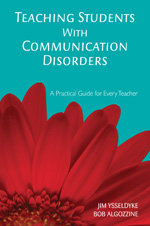Hands-on, Practical Guidance for Educators
From math,
literacy, science, equity, multilingual learners, and SEL, to assessment, school counseling,
and education leadership, our books are research-based and authored by experts
on topics most relevant to what educators are facing today.

Teaching Students With Communication Disorders
Strengthen the spoken and written expression of students with speech and language disorders!
The authors offer educators the tools to help identify communication disorders, distinguish speech from language impairments, reduce common communication problems, and work to eliminate negative stereotypes. Providing a pretest, additional resources to help teachers increase their effectiveness, this valuable resource highlights:
- Criteria for identifying speech and language disorders
- Cognitive, academic, physical, behavioral, and communication characteristics
- Appropriate teaching and class management strategies
- Trends and issues influencing instructional approaches and the delivery of speech and language services
- Grade Level: PreK-12
- ISBN: 9781412939034
- Published By: Corwin
- Year: 2006
- Page Count: 104
- Publication date: March 24, 2006
Review Copies
Other Titles in: Special Education Instruction | Speech Impairments | Teaching Methods & Learning Styles


